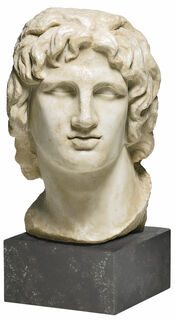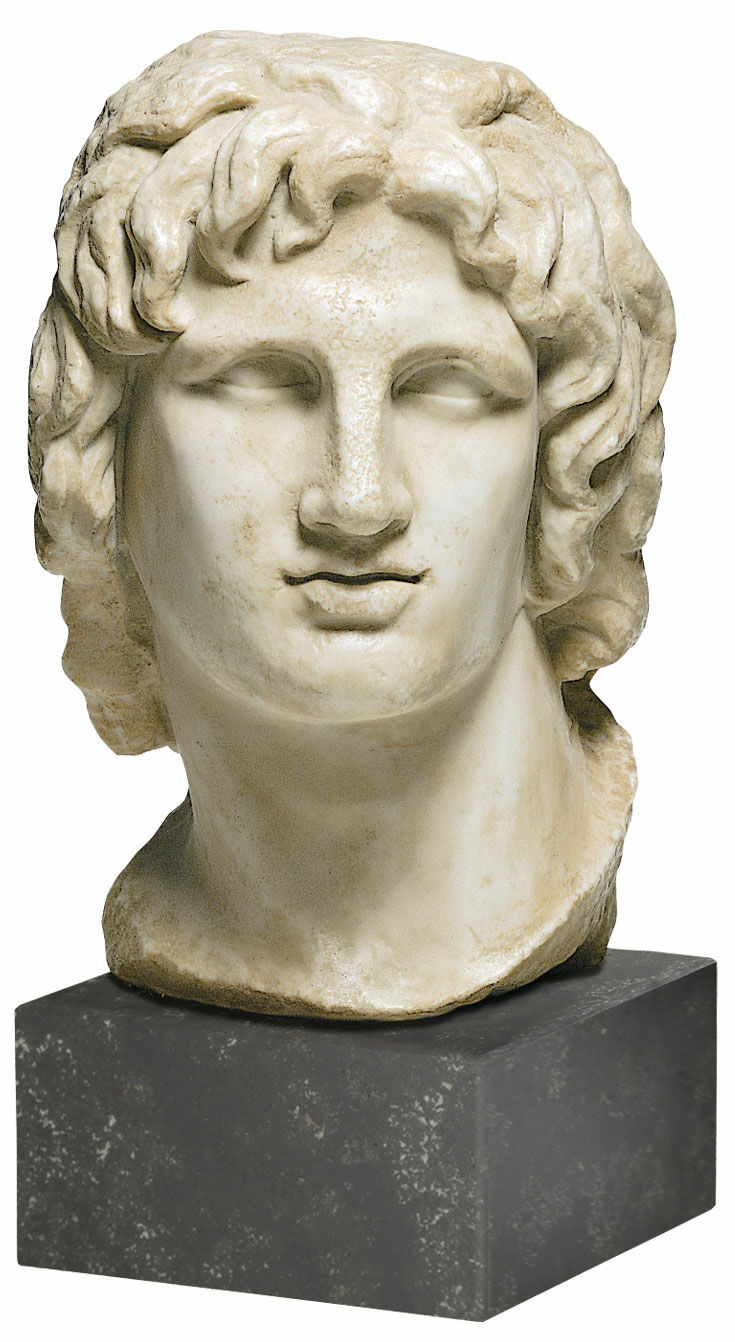Alexander the Great
Alexander the Great
Quick info
museum replica | cast + marble | handmade | height 49 cm
Detailed description
Alexander the Great
The desire for power is written on his face. He is a titanic, curly-haired young man with a faraway gaze, open, covetous lips and an energetic chin. Alexander was only 20 years old when he succeeded his father. In the following years he conquered the greatest empire that had ever existed before.
Original: British Museum London. Leochares. Around 338 BC, marble.
Polymer ars mundi museum replica cast by hand. Height with anthracite marble pedestal 49 cm.
About Leochares
Together with Praxiteles, Leochares is the most important Greek sculptor of the Late Classical period. He lived in the 4th century BC and probably came from Athens. Pliny puts his creative period between 370 and 320. Since only little is known about his life and work, his oeuvre can only be reconstructed based on copies.
However, it is certain that the artist was involved in the sculptural decoration of the Mausoleum of Mausolos at Halicarnassus around the year 350. According to Pliny, he is said to have made the panels with the Amazon battle frieze. However, the attribution of the models for the "Apollo Belvedere" and its counterpart, the "Artemis of Versailles" remains controversial.
The Greek sculptor's great fame among his contemporaries was based primarily on his portraits and images of the gods. Before 338 BC, for example, he was commissioned to depict the royal family of Philip II of Macedon as a family portrait in the Philippeion in Olympia. He also portrayed his son Alexander in other portrait busts. A work by Leochares that was still famous in Roman times was the statue depicting an eagle abducting Ganymede.
The free sculptural works have their peculiarity in their slender proportions and space-grasping movements. If the attributions are correct, he has shown unusual group dynamics for his time in the multi-figure scenes and decorative surface filling. Thus, his work stands at the threshold of the classical art of the 5th century BC towards Hellenism.
Sculptural representation of person's head and shoulders.
Minoan art, Mycenean art
The Cretan art is also named Minoan art, after the legendary King Minos.
Cretan-Minoan art is the art of Crete from about 2900 - 1600 B.C., the Mycenaean art of Crete and the Greek mainland is dated from about 1600 - 1100 B.C., on Crete only to 1200 B.C.
German archaeologist Heinrich Schliemann discovered significant evidence of this culture in the shaft graves of Mycenae, which had its heyday in the 14th and 13th centuries B.C. A well-preserved testimony is the Lion Gate from the 13th century B.C.
Splendidly decorated vases are the artworks of ceramics that have best survived the turmoil of millennia. The Snake Goddess (around 1500 B.C.), a faience figurine, that has been discovered in the Repositories Temple of the Knossos palace are also famous. Bronze vessels of that time were primarily used in the household. Daggers, swords and armour were also made of bronze.
The jewellery of the Cretan-Mycenaean ladies was made of gold, rock crystal, lapis lazuli, ivory, faience and glass.
Geometric art
The geometric art developed as a continuation of the late Mycenaean art on the Greek mainland towards the end of the late 11th century B.C. Mathematically regulatory will of style entered the geometric art replacing the natural Crete-Mycenaean formal language. Another new feature was the use of the ruler and the compass. The jewellry of this time is also based on strict geometric principles.
Archaic art
The art of building developed on the temples developed in the 8th and 7th century B.C. Initially, mudbrick and wood were used for building, later the forms were transferred to stone. A monumental style developed in sculpture. Marble, bronze, clay and limestone were used as materials. Gods, heroes, victorious competitors were embodied in typical young nude statues. However, gods or other consecration figures were portrayed in clothes.
In addition to freestanding sculptures, relief art developed, which was preferably used for decoration of temples.
Statuettes made of clay and bronze first appeared in the 6th century B.C. They depicted humans, animals and mystical beings and are of high quality.
Classical art (5th and 4th century B.C.)
The beginning of the Greek Classical period coincides with the time of the great statesman Pericles. Because of his democratic politics, Athens became the centre of cultural life and artistic creation in ancient Greece.
The classic architecture refined the shapes and proportions to perfection. The Temple of Zeus at Olympia, the Parthenon on the Acropolis of Athens and other major temple buildings were built in that time.
In the field of sculpture, the time of the Severe style began. The rigid forms of the earlier period were outdated, the human body was studied anatomically. Top works of the Severe style include the Charioteer of Delphi and the Artemision Bronze, which was recovered from the sea by fishermen.
A further increase brought the High Classical sculpture. Sculptors like Myron, Phidias and Polykleitos created sculptures that affect the statuary art to the present day (e.g. "Discobolus ", "Athena-Marsyas group" and "Riace bronzes" etc.)
In the 4th century, a romantic conception prevailed. Praxiteles and Lysippos determined the art of the time. Sculptures such as "Hermes and the Infant Dionysus", "Pouring Satyr" and especially the "Aphrodite of Knidos" are magnificent examples of the artistic conception of Classical Greece.
Hellenistic art
With Alexander the Great's campaigns of conquest, the Greek art dominated the Mediterranean and the Orient. In the temple construction, the Ionic and Corinthian style prevailed.
Lysippos initiated the sculptural art of the Hellenistic period. The temple complexes, such as the one in Pergamon, were richly decorated with statues. The "Winged Victory of Samothrace" was created at the beginning of the 2nd century B.C. and the "Venus de Milo" – towards the end of the century. The era of Hellenistic sculpture reached a final climax with "Laocoön Group". The Painting of that period was determined by Apelles. The Hellenistic painters depicted themes like historical events, portraits and genre paintings.
Collective term for all casting processes that ars mundi carries out with the help of specialised art foundries.
Stone casting
Similar to artificial marble, with the difference that the substitute stone in powder form is used instead of marble powder.
Bonded Bronze (Cold-Cast-Bronze)
Bronze powder is polymer-bonded. Special polishing and patination techniques give the surface of the casting an appearance similar to the bronze.
Imitation Wood
In order to guarantee absolute fidelity to the original, an artificially manufactured imitation wood is used as a base material that features typical wood characteristics: density, workability, colour and surface structure.
Ceramic Mould Casting
Ceramic mould casting usually requires the use of casting clay, which is then fired and optionally glazed. Instead of the usual rubber moulds, plaster moulds are often used in ceramic casting and porcelain production.
Cast Bronze (Lost-Wax Casting)
For the cast bronze, the thousand-year-old lost-wax technique is used. It's the best, but also the most complex method of producing sculptures.
A true-to-the-original reproduction of an artwork in the same size and with the best possible material and colour uniformity.
The mould is usually taken directly from the original so that the replication reproduces even the finest details. After casting the replication, using the most appropriate method, the surface is polished, patinated, gilded or painted according to the original.
A replication of ars mundi is a recognizable copy of the original.
A plastic work of sculptural art made of wood, stone, ivory, bronze or other metals.
While sculptures from wood, ivory or stone are made directly from the block of material, in bronze casting a working model is prepared at first. Usually, it is made of clay or other easily mouldable materials.
The prime time of sculpture after the Greek and Roman antiquity was the Renaissance. Impressionism gave a new impulse to the sculptural arts. Contemporary artists such as Jorg Immendorf, Andora, and Markus Lupertz also enriched sculptures with outstanding works.


